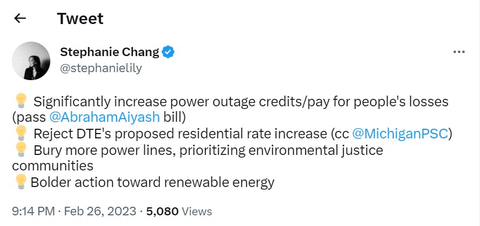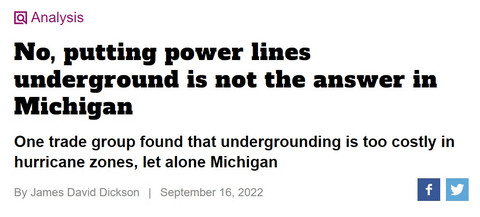DTE will never trim enough trees to avoid mass power outages in Southeast Michigan.
Every time bad weather hits — whether the thundersnow last week, the ice storm last week the previous week, or the wind storm last August — the utility giant blames our trees. DTE promises to cut more of them, faster. Everybody goes back to their lives, then they hold their breath when the wind blows.
If trimming trees were the answer, wouldn’t we know it by now, with DTE spending $190 million per year doing it?
Trees aren’t the problem, and it was wrong to blame Mother Earth for our troubles. The intersection of trees and power lines is the problem.
Nobody wants to say the thing, because it’s expensive and will take years. But burying power lines underground is the ultimate answer in Michigan.
It would cost billions, up to $30 billion by one estimate, just in the DTE area. When one solution costs millions and the other costs billions, thinking small makes sense. But thinking small got us here. It’s not our path forward.
DTE has plunked $3 billion into renewable energy projects since 2009, with plans to spend another $2 billion. What if 80% of that money and the tree-trimming money had been spent burying power lines?
Last year, DTE requested a retail price hike of $388 million. The Michigan Public Service Commission approved only $30.5 million, or about 8% of what the energy giant asked for.
Lansing has grown tired of DTE asking for more money to sing the same old song.
Only a dynamic plan is worth a dynamic rate increase. Nothing short of a public intention to bury power lines will excite the people of Michigan.
There are 500 comments on the DTE rate case. Most of them oppose any price hike.
“I understand infrastructure improvements require heavy investments, but given the absolute failure of this company to provide reliable service, it’s a bad joke for them to expect the customers or taxpayers to provide those funds,” one commenter wrote. “Allowing them to pass these costs onto the consumer would be an absolute failure of our legislature.”
It’s not unusual for the public to talk like that. What’s new is, last week, Michigan lawmakers joined them.
Rep. Abraham Aiyash, D-Hamtramck, seeks time-based reimbursements when customers are without power. The longer the outage, the bigger the reimbursement. Aiyash, who is majority floor leader for the House Democrats, has also called for legislative hearings.

Sen. Stephanie Chang, D-Detroit, joined the call for hearings. Chang also said DTE should bury more power lines underground. That’s the consensus this moment deserves.

DTE has donated to 93% of Michigan lawmakers. But power outages fall on the just and the unjust. On the well-connected and the average citizen. Lawmakers aren’t just voicing the righteous anger of their voters. They lost power, too.
DTE has papered Lansing with millions in donations and lobbying. And in the space of two storms, a lot of that goodwill has dried up.
There’s only one move left for DTE: Announce its intention to bury the 70% of power lines that are still above ground.
At a time when road spending is up in Michigan, burying power lines could work in tandem. When a road is replaced, its nearby power lines would be buried underground.
Think of it like the lead service line replacements across Michigan. It was annoying when it was on your block. Then, one day, the lead lines were gone, and there was a new road built.
The people of Michigan would be patient, if we knew the pain had a purpose. If we knew that today’s inconvenience would save us future worry. Someday, it would be nice to just enjoy the Michigan weather. Not fear it.
DTE’s friends in Lansing need to tell the company the truth. They need to tell DTE to stop tilting at windmills, and focus on burying power lines.
Energy reliability is job no. 1 for an energy company. Not political donations. Not lobbying. Not experimental green energy projects.
Due to cost and staffing, the big dig won’t happen overnight. Our problem is, we haven’t even started. Admitting is the first step. And up until now, we’ve been satisfied with the tree-trimming narrative. Show of hands: Who’s still buying that?
We’ve seen wind, rain and ice wreck the grid in recent years. The weather in Michigan isn’t getting any better; DTE would say so itself. So we must make plans to avoid it.
I was wrong about this last year when I wrote that burying power lines underground was too expensive.

Undergrounding is expensive, yes.
But so are renewables. So are massive outages that force DTE to call in line workers from all over the Midwest, paying for their work, their lodging, and their meals. So are $35 rebates to a half-million customers. So is annual tree-trimming.
Everything costs money. Only one answer, burying power lines underground, would make our energy more reliable in the long term. Windmills won’t. Solar panels won’t. Trimmed trees won’t.
For DTE, this is the flip side of monopoly status. This is the hard part. When you present yourself as an energy giant, people expect big things from you. No more trimming around the edges. Time for a serious plan.
It’s time for DTE to deliver the public works project of the 2020s by burying power lines. Whether by choice, or at the behest of its friends in Lansing.
James David Dickson is managing editor of Michigan Capitol Confidential. Email him at dickson@mackinac.org.
|

DTE can’t tree trim its way to reliability
After ice storms and thundersnow cause mass outages, DTE must admit: Burying power lines underground is the answer
DTE will never trim enough trees to avoid mass power outages in Southeast Michigan.
Every time bad weather hits — whether the thundersnow last week, the ice storm last week the previous week, or the wind storm last August — the utility giant blames our trees. DTE promises to cut more of them, faster. Everybody goes back to their lives, then they hold their breath when the wind blows.
If trimming trees were the answer, wouldn’t we know it by now, with DTE spending $190 million per year doing it?
Trees aren’t the problem, and it was wrong to blame Mother Earth for our troubles. The intersection of trees and power lines is the problem.
Nobody wants to say the thing, because it’s expensive and will take years. But burying power lines underground is the ultimate answer in Michigan.
It would cost billions, up to $30 billion by one estimate, just in the DTE area. When one solution costs millions and the other costs billions, thinking small makes sense. But thinking small got us here. It’s not our path forward.
DTE has plunked $3 billion into renewable energy projects since 2009, with plans to spend another $2 billion. What if 80% of that money and the tree-trimming money had been spent burying power lines?
Last year, DTE requested a retail price hike of $388 million. The Michigan Public Service Commission approved only $30.5 million, or about 8% of what the energy giant asked for.
Lansing has grown tired of DTE asking for more money to sing the same old song.
Only a dynamic plan is worth a dynamic rate increase. Nothing short of a public intention to bury power lines will excite the people of Michigan.
There are 500 comments on the DTE rate case. Most of them oppose any price hike.
“I understand infrastructure improvements require heavy investments, but given the absolute failure of this company to provide reliable service, it’s a bad joke for them to expect the customers or taxpayers to provide those funds,” one commenter wrote. “Allowing them to pass these costs onto the consumer would be an absolute failure of our legislature.”
It’s not unusual for the public to talk like that. What’s new is, last week, Michigan lawmakers joined them.
Rep. Abraham Aiyash, D-Hamtramck, seeks time-based reimbursements when customers are without power. The longer the outage, the bigger the reimbursement. Aiyash, who is majority floor leader for the House Democrats, has also called for legislative hearings.
Sen. Stephanie Chang, D-Detroit, joined the call for hearings. Chang also said DTE should bury more power lines underground. That’s the consensus this moment deserves.
DTE has donated to 93% of Michigan lawmakers. But power outages fall on the just and the unjust. On the well-connected and the average citizen. Lawmakers aren’t just voicing the righteous anger of their voters. They lost power, too.
DTE has papered Lansing with millions in donations and lobbying. And in the space of two storms, a lot of that goodwill has dried up.
There’s only one move left for DTE: Announce its intention to bury the 70% of power lines that are still above ground.
At a time when road spending is up in Michigan, burying power lines could work in tandem. When a road is replaced, its nearby power lines would be buried underground.
Think of it like the lead service line replacements across Michigan. It was annoying when it was on your block. Then, one day, the lead lines were gone, and there was a new road built.
The people of Michigan would be patient, if we knew the pain had a purpose. If we knew that today’s inconvenience would save us future worry. Someday, it would be nice to just enjoy the Michigan weather. Not fear it.
DTE’s friends in Lansing need to tell the company the truth. They need to tell DTE to stop tilting at windmills, and focus on burying power lines.
Energy reliability is job no. 1 for an energy company. Not political donations. Not lobbying. Not experimental green energy projects.
Due to cost and staffing, the big dig won’t happen overnight. Our problem is, we haven’t even started. Admitting is the first step. And up until now, we’ve been satisfied with the tree-trimming narrative. Show of hands: Who’s still buying that?
We’ve seen wind, rain and ice wreck the grid in recent years. The weather in Michigan isn’t getting any better; DTE would say so itself. So we must make plans to avoid it.
I was wrong about this last year when I wrote that burying power lines underground was too expensive.
Undergrounding is expensive, yes.
But so are renewables. So are massive outages that force DTE to call in line workers from all over the Midwest, paying for their work, their lodging, and their meals. So are $35 rebates to a half-million customers. So is annual tree-trimming.
Everything costs money. Only one answer, burying power lines underground, would make our energy more reliable in the long term. Windmills won’t. Solar panels won’t. Trimmed trees won’t.
For DTE, this is the flip side of monopoly status. This is the hard part. When you present yourself as an energy giant, people expect big things from you. No more trimming around the edges. Time for a serious plan.
It’s time for DTE to deliver the public works project of the 2020s by burying power lines. Whether by choice, or at the behest of its friends in Lansing.
James David Dickson is managing editor of Michigan Capitol Confidential. Email him at dickson@mackinac.org.
Michigan Capitol Confidential is the news source produced by the Mackinac Center for Public Policy. Michigan Capitol Confidential reports with a free-market news perspective.
More From CapCon